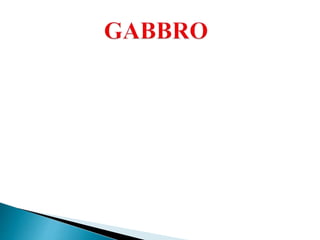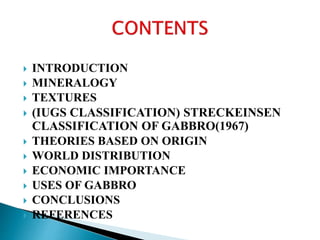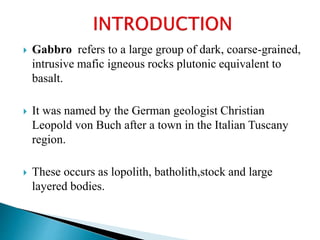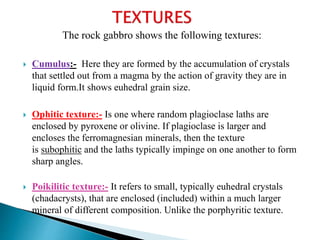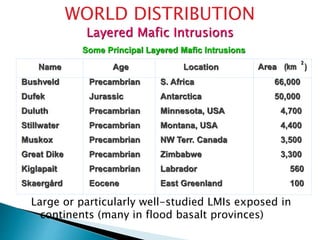Gabbro
- 2. INTRODUCTION MINERALOGY TEXTURES (IUGS CLASSIFICATION) STRECKEINSEN CLASSIFICATION OF GABBRO(1967) THEORIES BASED ON ORIGIN WORLD DISTRIBUTION ECONOMIC IMPORTANCE USES OF GABBRO CONCLUSIONS REFERENCES
- 3. Gabbro refers to a large group of dark, coarse-grained, intrusive mafic igneous rocks plutonic equivalent to basalt. It was named by the German geologist Christian Leopold von Buch after a town in the Italian Tuscany region. These occurs as lopolith, batholith,stock and large layered bodies.
- 4. Gabbro is dense, greenish or dark-colored and contains pyroxene, plagioclase, amphibole, and olivine (olivine gabbro when olivine is present in a large amount). The pyroxene is mostly clinopyroxene; small amounts of orthopyroxene may be present. If the amount of orthopyroxene is substantially greater than the amount of clinopyroxene, the rock is then a norite. Quartz gabbros are also known to occur and are probably derived from magma that was over-saturated with silica. Gabbros contain minor amounts, typically a few percent, of iron- titanium oxides such as magnetite, ilmenite.
- 5. Plagioclase (labrodorite ,bidunite ,or rarely anorthite) Clinopyroxene (augite or diapside) Orthopyroxene (hypesthene &rarely enstetite) Olivine Hornblende Biotite (as altered product) Quartz(quartz gabbros) Orthoclase Apatite, titaniferrous magnetite, illmnite, pyrite, pyrrhotite are the accsessary minerals.
- 6. The rock gabbro shows the following textures: Cumulus:- Here they are formed by the accumulation of crystals that settled out from a magma by the action of gravity they are in liquid form.It shows euhedral grain size. Ophitic texture:- Is one where random plagioclase laths are enclosed by pyroxene or olivine. If plagioclase is larger and encloses the ferromagnesian minerals, then the texture is subophitic and the laths typically impinge on one another to form sharp angles. Poikilitic texture:- It refers to small, typically euhedral crystals (chadacrysts), that are enclosed (included) within a much larger mineral of different composition. Unlike the porphyritic texture.
- 7. Orbicular texture:-here the rock are charecterised by oval to circular patches usually consists of cores of plagioclase enclosed with alternating rings of pyroxenes or hornblende. Symplectitic intergrowth:- It consists of myrmekite like bulbous outgrowth of plagioclase , occasionally twinned in normal manner,riddled with vermicular inclusions of orthopyroxene. Corona texture:-It consists of zone of minerals, usually with radial arrangement around another mineral.
- 8. Gabbro Photomicrograph of a thin section of gabbro. Orbicular texture
- 9. Cumulate texture Ophitic texture Poikilitic texture
- 10. Gabbro Norite (IUGS Classification) Streckeinsen Classification Of Gabbro(1967)
- 12. Possible explanation involves multiple injection of batches of identical magma, which subsequently differentiate to produce each cycle. Similarities between bedding and grain fabric of clastic sedimentary bodies with the rhythmic layering and cumulus fabric of stratiform intrusions suggest similar process of sedimentation has been considered to involve simultaneous gravity induced crystal settling. Convection was responsible for the rhythmic layering, igneous layering cross bedding. Here the magma near the roof would begin to crystallize first become denser gravitationally unstable would like to sink along the walls of intrusion and spread horizantal along the floor.
- 13. At a number of times in the earth history particularly during the Precambrian, conditions varied as continental rifting and meteoritic impact led to the development of enormous volumes of tholeitic magma which on slowly cooling differentiated into remarkable suites of cumulates.
- 14. The form of a typical LMI
- 15. Large or particularly well-studied LMIs exposed in continents (many in flood basalt provinces) Some Principal Layered Mafic Intrusions Name Age Location Area (km 2 ) Bushveld Precambrian S. Africa 66,000 Dufek Jurassic Antarctica 50,000 Duluth Precambrian Minnesota, USA 4,700 Stillwater Precambrian Montana, USA 4,400 Muskox Precambrian NW Terr. Canada 3,500 Great Dike Precambrian Zimbabwe 3,300 Kiglapait Precambrian Labrador 560 Skaergård Eocene East Greenland 100 WORLD DISTRIBUTION Layered Mafic Intrusions
- 16. Bush weld igneous complex - South Africa The Stillwater Complex, Montana Great dyke – Zimbabwe
- 17. Gabbro layered intrusions though few in number contain the worlds main reserves of chromium and platinum.The so called chromite horizon in bushweld &stillwater more specially layers are found with olivine rich peridotites, orthopyroxenites. It also contains larger number of titano magnetite layers Fe, Ti, vanadium ,Tin. It also yielded nickel, copper, cobalt, sulfur, gold, silver, tellurium, pyrrhotite, chalcopyrite. Gabbro sometimes contains economic amounts of some relatively rare metals. Gabbros containing significant amounts of the mineral ilmenite are mined for their titanium content.
- 18. Gabbros are popularly known as “Black granites”. Brightly polish gabbro is used to make cemetery markers, kitchen counter tops, floor tiles, facing stone and other dimension stone products. It is also used to make a number of rough-cut products such as curbing, ashlars, paving stones and other products. Crushed gabbro is used as a base material in construction projects, as a crushed stone for road construction.
- 19. It is a highly desirable rock that stands up to weathering. Most of the intrusions are lopolith, some are elliptical or lobate in plan such as Bushweld complex of South Africa. It contains economic amount of rare minerals. It is of great economic importance. These rocks get altered to chlorite, serpentine, talc, & clay minerals.
- 20. Donald W.Hyndman-1972-Petrology of igneous and metamorphic rocks-Pp-105- 113,222-232. Myron G.Best-1976-Igneous and metamorphic petrology-CBS publishers and distributors Delhi-Pp:-167-16 http://www.ucl.ac.uk/es/impact/geology/lon don/glossary/rocks/igneous/gabbro http://www4.nau.edu/meteorite/Meteorite/B ook-Textures.html http://geology.com/rocks/gabbro.shtml
